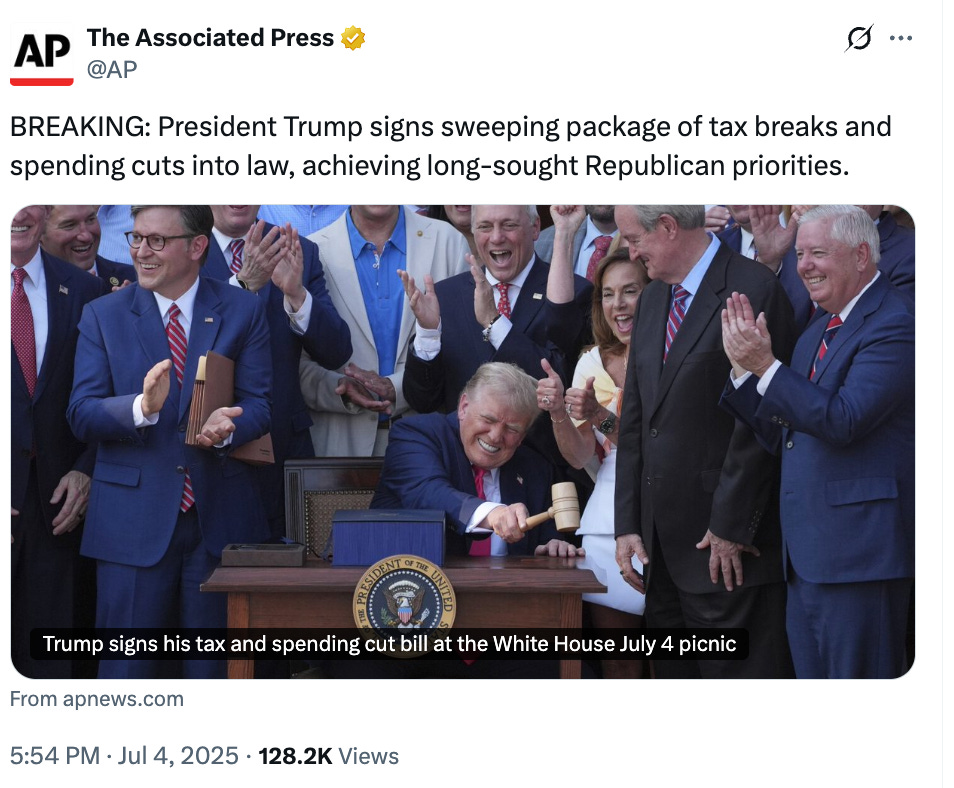This and That: A post-Fourth edition
Takes on the ‘Big Beautiful Bill’ as Trump signs it. The WWII-era story behind Squirtgun’s first track in two decades. And more
Thanks today for ongoing help from Based in Lafayette sponsor Long Center for the Performing Arts in downtown Lafayette, presenting this summer’s season of shows at Loeb Stadium in Lafayette’s Columbian Park. For tickets and details on all the shows and events, go to longpac.org.
This and That and some Other Reads for the day after the Fourth.
FOLLOWING UP ON TRUMP’S TAXING AND SPENDING BILL
President Donald Trump on Friday signed the massive taxing and spending legislation he’d dubbed the “One Big Beautiful Bill.”
Washington Post reporters Matt Viser and Cat Zakrzewski opened a July 4 article with the scene outside the White House this way:
“President Donald Trump on Friday, with the nation at cookouts and preparing for sparkler-filled evenings, flooded the South Lawn of the White House with a mixture of patriotic festival and a celebration of his biggest legislative accomplishment.
“The president who has signed a historic number of executive orders finally got his dream of signing a signature policy bill that contains a collection of his campaign promises.
“And then, expected by dusk, the fireworks.
“It was the culmination of a string of successes in recent weeks and a remarkable display of how Trump has been able to bend to his will both allies and adversaries, world leaders and university presidents, media executives and judges. …
“‘I think I have more power now, I do,’ he said on Thursday, when asked about the difference between his first and second terms. ‘More gravitas. More power.’”
Here’s more on the bill and reaction:
Associated Press reporters Kevin Freking and Lisa Mascaro had this: “President Donald Trump on Friday signed the tax and spending cut bill Republicans muscled through Congress this week, turning it into law by his own self-imposed Fourth of July deadline. At nearly 900 pages, the legislation is a sprawling collection of tax breaks, spending cuts and other Republican priorities, including new money for national defense and deportations.” For more: “What’s in the tax and spending bill that Trump has signed into law.”
The Washington Post reporters Julie Zauzmer Weil, Yasmeen Abutaleb and Jacob Bogage broke down the elements in the bill here: “How Trump’s big bill will affect you, from Medicaid cuts to tax credits.”
FactCheck.org, via the Annenberg Public Policy Center, had this take on the rhetoric and disparate interpretations from all sides on the bill, as it neared a final vote: “Unraveling the Big Beautiful Bill Spin.”
Wall Street Journal reporters Aaron Zitner, Lindsay Wise and Natalie Andrews opened a campaign-to-come piece this way: “Republicans had a hard time persuading some of their own lawmakers to support the party’s big tax-cutting and domestic-policy bill. They might have an even harder time selling it to the public. Polls show that the bill is unpopular. Opposition outweighed support by more than 20 percentage points in recent Fox News and Quinnipiac University polls. Some Republican lawmakers facing tough races next year represent the most Medicaid-reliant districts. They will have to defend the big cuts in the bill to Medicaid, the health-insurance program for low-income and disabled people, as well as to rural hospitals and to nutrition assistance, once known as food stamps. Those cuts help fund tax cuts in the bill that President Trump called for during the 2024 campaign.”
The Indianapolis Star had this on the Indiana delegation’s vote, which fell directly along party lines: “How Indiana's U.S. representatives voted on the 'Big Beautiful Bill.’”
U.S. Rep. Jim Baird, a Greencastle Republican who represents Tippecanoe County among those in the 4th District, cheered on Trump’s bill from start to finish. He released this statement after the House vote: “After months of hard work and thoughtful deliberation, I was proud to vote for the One Big, Beautiful Bill and help send it to President Trump’s desk. This includes much-needed tax relief for the American people. This bill delivers the largest tax cut in American history for workers, families, and seniors by ending taxes on tips and overtime for millions of workers and slashing taxes on Social Security. It also makes a generational investment in Rural America by expanding crop insurance, strengthening biosecurity measures, and boosting investment in the farm safety net, and it prevents a Death Tax increase that would devastate thousands of family farms in Indiana’s Fourth Congressional District. On top of these monumental wins, the One Big Beautiful Bill invests in our border security to deliver the most secure border on record and delivers on President Trump’s successful foreign policy of peace through strength. There has been a lot of misleading information on this bill. This legislation strengthens federal programs for those who truly need them and enacts common-sense work requirements that a majority of Americans support. Additionally, the Congressional Budget Office (CBO) score assumes an incorrect baseline that simply does not reflect current policy. In reality, the One Big Beautiful Bill reduces the deficit, marking a long-overdue return to fiscal sanity in Washington. This bill ultimately fulfills many of the promises made to the American people.”
Karen Tallian, Indiana Democratic Party chair, called bullshit. In a statement calling out some of her former colleagues at the Statehouse after the U.S. House vote, Tallian said: “Indiana Republicans should feel ashamed. This bill is the worst piece of legislation to come out of Congress in decades, and is likely the biggest transfer of wealth from poor to rich that the US has ever seen. I served with several of these now members of Congress during my time in the Indiana General Assembly, and all of them at least pretended to have a moral compass. Now, they gleefully cheer as they trade the lives of the poor, the children and the elderly for yet another bullshit tax break for billionaires. People will die. Hundreds of thousands of Hoosiers are now at risk because they will lose access to food and healthcare. Predictions are that millions around the rest of the world will die because of the stingy, miserly cut to USAID. All so that a few Republican mega donors could buy themselves another yacht. Americans have always been generous, unselfish and compassionate. Apparently, our GOP legislators are not. I am disgusted.”
And this still hangs out there, documented in a Q&A last week in BiL with Kier Crites Muller, president and CEO of Food Finders Food Bank, as the nonprofit geared up for anticipated fallout from social service cuts in the measure.
Thinking about subscribing to Based in Lafayette? Now’s the time.
THE TRAGIC WWII STORY BEHIND SQUIRTGUN’S FIRST SONG IN TWO DECADES
I caught up with Mass Giorgini – Lafayette native, punk royalty as mastermind of the late, great Sonic Iguana recording studio and now living with his family in Rome – after the recent release of “Sunflowers,” the first song in 22 years from Squirtgun. What a backstory, too.
Giorgini called the song a debut from a sort of all-star “Supersoaker lineup” of the punk band, including founding member Flav Giorgini on guitar; Kevin Sierzega (Teen Idols, Bullets to Broadway, PT’s Revenge) on lead vocals; Zac Damon (Screeching Weasel, Big in Japan, Zoinks!) on lead guitar; and Dan “Panic” Sullivan (Screeching Weasel, Riverdales, Queers, Avengers) on drums and backing vocals. Giorgini plays bass. It all comes ahead of an Italian festival in July called Punk Rock Raduno, where organizers asked for contributions of a previously unreleased track for a compilation from bands playing the festival.
“So why now?” Giorgini said about the new material. “Partly, it’s the awareness that I’m not that kid anymore — the one standing in the front row of punk shows, dreaming about changing the world. I can look back 40 years and recall the bands and songs that shaped me. But I can’t look forward 40 years and assume I’ll still be here to share the stories that matter most. That urgency — that fragile truth — is what pushed me to start writing the story of Mario Calvi in prose and in song. To make sure it doesn’t vanish.”
Here's his description of the story behind the lyrics, recounting extended family lore dating to the end of World War II.
“The song is my attempt to tell, through music, the story of Mario Calvi — a young anti-fascist fighter who I always called “Uncle Mario,” though he wasn’t technically a blood relative. He was possibly engaged—or maybe just sweethearts—with my great-aunt Rina, who lived on the ground floor of the same two-family farmhouse where he and his mother, Pia, lived upstairs. The truth of their bond is now somewhat lost to time. In Italy, the word fidanzati floats somewhere between “sweethearts” and “fiancés,” so whether they were formally promised or simply in love is something I’ll never be able to say for sure. But the love — that part, I believe.
“The facts, though, are painfully clear. April 25, 1945, is Liberation Day in Italy — the symbolic anniversary of the Resistance’s triumph over fascism in the north. On that day, Nazi and Fascist forces fell in key cities like Torino and Milano. Mario, just 23 years old and a fighter in the Muzio Brigade of the partigiani, began his journey home at last. On the afternoon of April 26th, he arrived in his tiny hamlet of Torre dei Cani, near San Martino Siccomario in Lombardia.
“He pedaled the final stretch on a bicycle, down a gravel road lined with sunflowers. The story — etched into my family’s memory like something out of neorealist cinema — goes like this: villagers saw him first and began to cheer. His mother Pia stepped outside. Mario threw down his bike and ran the last few meters toward her, arms outstretched. …
“But he never reached her. A group of Nazi soldiers—still unaware their side had lost—were hidden in the nearby sunflowers. One of them fired a shot. Mario fell just yards from his home. My mother was seven years old that day. She and her family were visiting Aunt Rina to celebrate the end of the war. She saw the whole thing unfold—ssomething I can still hear in her voice from when she used to tell the story, her eyes glassing over, even decades later.”
Here's a look at the monument that stands on the spot today.
“It felt like fate,” Giorgini said. “Mario Calvi’s story took place in Lombardy, the very same region where the festival would be held. The setting, the history, the timing — it all aligned.”
Here’s the track:
For more, here’s a Q&A by BiL correspondent Tim Brouk, circa August 2022:
ABOUT THOSE GREEN WAGONS: J&C reporter Jillian Ellison had a nice piece on the always-anticipated rush on farmer’s dozens of sweet corn from Prairie View Farms in Battle Ground. More than announcing the return of the green wagons stationed around Greater Lafayette – in itself, a summer headline, for sure – this one is an origin story for Stephen Okos’ foray into the sweet corn harvest as owner of Prairie View Farms Produce. It starts with a desire for a pickup truck. Ellison tells the story here: “Prairie View Farms Produce returns to Lafayette, celebrating over 30 years of sweet corn.”
Thanks, again, for ongoing support from Based in Lafayette sponsor Long Center for the Performing Arts in downtown Lafayette. For tickets and details on all the shows and events, go to longpac.org.
Thank you for supporting Based in Lafayette, an independent, local reporting project. Free and full-ride subscription options are ready for you here.
Tips, story ideas? I’m at davebangert1@gmail.com.









We could save a lot of money each year by replacing Jim Baird and his office with a line of code that says “IF Trump says yes THEN yote yes ELSE vote no”
Indiana, where recreational explosives are cool and trans kids are dangerous. I need to go to a place where those are flipped.